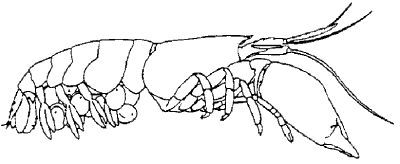 |
Science Frontiers ONLINE No. 107: Sep-Oct 1996 |
|
|
High Social Order In A New Order
When divers explore the coral reefs off the coast of Belize, they hear a an underwater sound like frying bacon. This sound emanates from the snapping claws of Synalpheus regalis, popularly called snapping shrimp. These diminutive crustaceans live in colonies in the channels of sponges. The individual shrimp in these sponge-sheltered colonies are not all alike. The noise-makers are the "soldier" caste, which wield big "fighting claws." The "workers" that care for the young lack the large claws. All of the young shrimp are produced by a single "queen" shrimp, who is substantially larger than the soldiers and workers. The snapping shrimp social order sounds a lot like that found in bee hives and termite mounds. The snapping shrimp are, in fact, "eusocial" like the social insects. They are the only known eusocial members of the Order Crustacea.
Eusociality is considered to be at the apex of animal social organization. What forces have fostered its development in three diverse groups -- insects, mammals (the naked mole-rats), and now the crustaceans? How did the different castes evolve, especially the sterile castes? It must have taken a lot of random mutations to develop such greatly different body forms in a coordinated way such that colonies were continuously viable!
Obviously, we have a lot to learn about these snapping shrimp. Are new colonies formed when sexual forms disperse, as with ants and termites; or are there "dispersive morphs" created, as with the naked mole-rats? (See SF#106)
(Duffy, J. Emmett; "Eusociality in a Coral-Reef Shrimp," Nature, 381, 1996. Adler, T.; "A Shrimpy Find: Communal Crustaceans," Science News, 149:359, 1996)
 | A "soldier" snapping shrimp with a huge "flighting claw". Overall length: only about half an inch. (Nature) |